The Winning Recipe
There are some key ingredients that will yield success in the living room. The first company to concoct this recipe has the chance to dominate all the other players. Imagine this:
What if the last version of Apple TV had included the App Store, operated by a Apple-developed Wii Remote clone. An Apple Wii, if you will. You would find all the same gameplay that you find on the Wii (and which made it a massive success) at a lower price point with less time investment required, in addition to a flood of new content from the iOS developer ecosystem. You would find great new apps built just for the living room. The iOS home screen of apps and the Wii OS home screen of channels are remarkably similar, aren’t they? It’s not that hard to imagine.
An open platform app store is the first ingredient of the winning recipe.
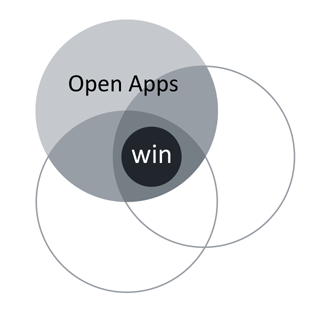
The second ingredient is a business model for TV and Movies. Remember, people will buy this box for Smart TV, games will be secondary.
Everybody cringes at the thought of yet another set top box in their living room to go along with their Cable/Satelite, DVR, and game console. Nobody wants a box to manage their other boxes, what they want is a simple replacement for all that expensive garbage. The winner’s core function will be as a modest replacement for cable/satellite TV – a destination for cord-cutters comfortable with the likes of Hulu and Netflix.
Flat-fee subscription for all video is the way to deliver content en-masse. Convenience is king in changing customer behavior, and Netflix and the major Cable Networks have shown that subscription is the most convenient way to deliver big content.
If we look far into the future, an “on demand” a-la-carte model could work, but only once the UI for these new boxes becomes second-nature for the users and futuristic Smart TV behaviors become common and standardized. Until then, it’s too much of a hassle for couch surfers. With subscription, you can pay-and-forget, never having to worry about access ever again, so it’s the most attractive core business model here.
Adding that ingredient in, here’s the recipe so far:
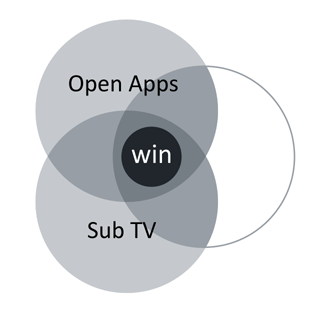
Note that Netflix will take care of the subscription video option admirably for pretty much everybody. It’s on every box right now, the question is whether the value of Netflix can continue to grow in the face of a souring reputation among content owners. Don’t forget that Cable/Satellite is in this fight, and they offer a better deal to the content owners right now. There is no way that the content holders will allow Netflix to become a monopoly channel and sink the value of content deals.
The uncertainty over Netflix is not the only thing that makes the TV ingredient matter. Consumers will care about it more than apps, initially. Every box-maker will want better quality content offering than the next guy. Integrated live TV would be a great competitive advantage, for example.
So, how do the competitors stack up against the recipe?
Google is arguably first into the ring with this new generation of boxes. GoogleTV is already out, and it is doing. . . not so great.
Google has problems with TV networks, most of whom are blocking it from accessing their free web episodes. Free access to that content could have been a big incentive for customers to switch to GoogleTV, but it is not in the best interest of the TV networks.
GoogleTV also features a overly complex controller design that isn’t even consistent across the platform at launch.
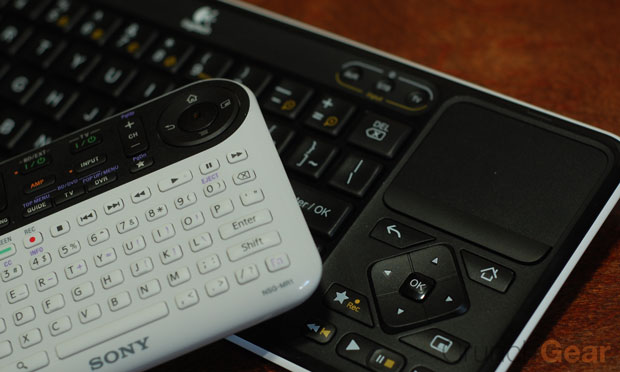
Even if it had the free content, the user experience would remain inconsistent and cumbersome. GoogleTV illuminates the colossal design problem in allowing a user to simultaneously control Live TV, a DVR, web browser, game, or Facebook app, from their couch (with one hand).
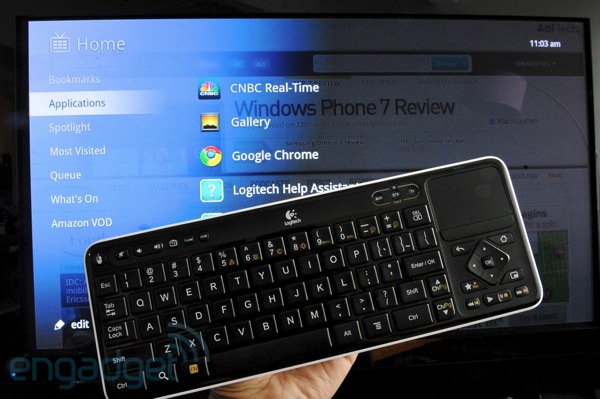
Yikes. The complexity of content available in the living room is one big design clusterfuck of a problem. Google’s attempt to answer that problem was search. Good idea, but search requires a keyboard and nobody wants to type on the couch, they want to surf (Google has reportedly gone back to the drawing board with their UX). The design clusterfuck cannot be solved with a standard TV remote or a wireless keyboard.
Here’s the key element that nobody seems to be paying attention to, the secret ingredient:
The winner will have a single, standard, incredibly awesome controller.
Remember my drawing at the beginning of the article with the ships converging on the TV? The winner will be the company that pulls the motion-sensing Excalibur from the stone. This unclaimed controller-based-UX is what unlocks the potential of Smart TV.
The final winning recipe:
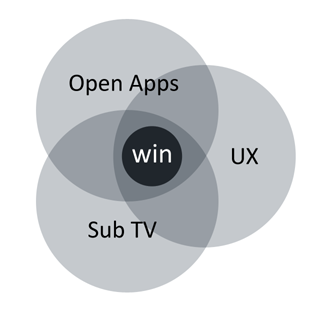
That’s UX with a great couch controller.
There’s a reason why so much high technology is being invested into things like the Wii Remote, Kinect, and Playstation Move. It really matters. Everyone acknowledges that UX is key, but it’s the control method that enables the UX.
How does GoogleTV even relate to gaming? Once you have the couch controller and the associated UX that solves the design problems of these boxes, it will undoubtedly be great for playing games as well. Remember what happened with iOS and Facebook? Neither multitouch screens nor accessible social networks were designed for gaming. They were simply excellent enablers.
To win, Google needs to direct a hardware partner to build them the magic controller. They will need to enforce a standard control design. That’s not a very Googly way of positioning their service – they like to be open, they don’t like to design hardware – but it’s a requirement for good UX in this case.
Google is first into the ring and first to get graded:
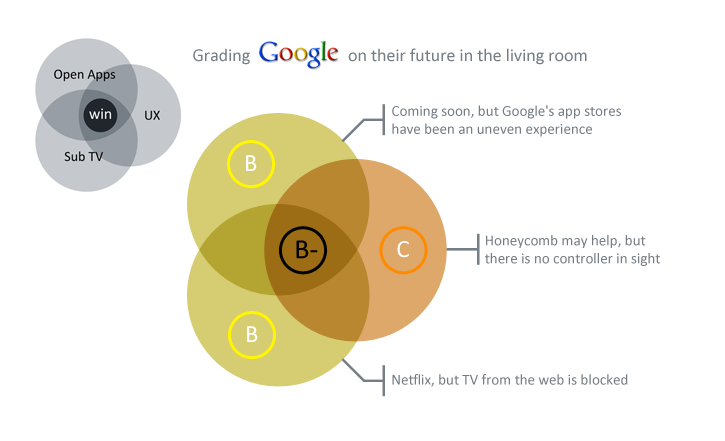

Nice article.
I think three things:
1. There’s no incentive for the content people to make this happen. I used to work for BSkyB on the interactive TV games as a producer, and for decades the various interactive teams inside Sky have been agitating for up to date technology, but companies like Sky won’t bite. Their reasoning, which is hard to argue with, is that they need to get cheap boxes into people’s homes that can carry digital signals, and once they’re in they have no incentive to go around replacing millions of boxes with technology that allows viewers to do things other than watch TV.
All the cable and satellite companies have the same problem, and they’ve spent a long time figuring out how to deliver VOD etc onto their existing technology as a result, and that’s not going to change. So that means that any extra Google or Apple box has to be in addition to the cable box, and not free. That’s a bit of a problem.
2. They may always end up falling between two stools. It’s hard to say what problem these devices actually solve. With VOD, DVR and hundreds of channels the average consumer arguably has far more video content than they actually need, so yet another source seems a bit frivolous. With game consoles that use dedicated (therefore better) controllers, the play experiences are very likely to be better and so the enhanced App Box’s versions might seem quite lightweight by comparison.
I think nobody has solved that question yet. Without a compelling problem to solve (and I’m not sure box reduction is that compelling) it has to be sold as an nice-to-have, which instantly reduces the market ubiquity.
3. Perhaps the solution is to go upwards. It doesn’t apply so much to Google, but what strikes me as odd is that Apple doesn’t have a gaming machine. They have all the components in place, from a development platform, to a commercial platform, an approvals department to a great reputation for designing awesome hardware. So isn’t the answer (for Apple at least) to do a PS1-era Sony and create a game console?
Overwhelmingy, I think yes. What they could do is create a console that is wholly iTunes based, uses the App Store etc, but sells big games as opposed to just Angry Birds. Of course it could do Angry Birds as well, but – notionally at least – they could take a huge wedge out of the business model of the disc-based platforms that exist today. That to me is the missing link in the chain, because it gets the Apple tv into the homes through replacement rather than as an additive box.
Summary:
All in all though, I think there will not be one mega-convergent box. The economics just don’t stack up and there’s too many power players on the content side who really don’t want that to happen. There’s nothing stopping a whole lot of disruption happening on the console side though.
Tadhg,
Thanks so much for the reply. Looking at this from the perspective of the TV world is the best way, and it’s the arena that I have the least experience in, so your comments mean a lot. The big media conglomerates will undoubtedly act as a massive drag on this transition. As you point out, they may prevent it from happening at all. After reading your reply and doing some more research, I can readily see how big of an obstacle it is that they represent.
However, with so many companies like Hulu and Netflix working on services that can offer these companies more revenue, not less, I think that angle can be solved. There are many incentives for MS, Sony, Apple and Google to bring a iOS-like experience to the living room (as described in the article). That pressure, and the competition between these companies has the potential to sidestep whatever challenges Sky, Time Warner, Comcast, and their ilk represent.
-Lucas
Another website, another disagreement with Tadhg.
(We’re mates, by they way, and have worked together in the past; whilst he was producing at BSkyB, I was producing at one of their developers. Part of my current day job involves working in the next-gen connected TV space.)
Just a couple of thoughts from me.
1) I don’t think that the connected-TV games market will start with trying to appeal to gamers that are already out there (i.e. your Xbox gamers, PS3 gamers, etc). So I *do* disagree with the idea of Apple bringing out a dedicated games console. From my point of view, games consoles already exist to meet the needs of dedicated gamers; they ain’t going anywhere just yet. Such a device – with App Store – would be a great step, and would shake up the established industry players, but it wouldn’t be disruptive from the consumer’s point of view.
2) I think the unmet consumer need will distil out of the mass of non-gamers who want quick, convenient distractions. People that are scared of traditional game controllers (the iPhone has shown that good content fits new non-scary controllers, so a traditional-style controller is by no means a pre-requisite for connected-TV gaming to properly take off), and that can’t be bothered turning on another box, waiting for it to boot up, then navigating menus until they finally get to the content they want.
Instead, here’s a thing (and I’m thinking on the fly here; I’ve not heard anyone posit anything similar to this before): games as channels.
The ideal setup for the traditional use case of the TV-watching experience, and for the traditional UX of the those slumped in front of the telly, is to have games ‘always on’. I’m thinking that (e.g.) Angry Birds is on channel 626. Flick to channel 626, and *there’s* Angry Birds, exactly where you left it. No loading time, no extra set-up, no nothing. It’s just another TV channel from the user’s point of view.
From a tech viewpoint, it’s similar to the iOS implementation of multitasking, I guess. It would be the ultimate in convenience, and would leverage pre-existing mental models of both TV channels and the TV-content consumption experience (meaning that there’s no learning going on; the entire experience is self-evident from start to finish).
As far as I know, none of the current or over-the-horizon boxes work in this kind of way. It’d make for a nigh-on perfect user experience, though, and could well be the blue touch paper that the space needs.
Pete,
Great comment. The Wii calls their games “channels,” but you don’t flip between them, you still have a loading screen. It’s essentially the same as the iOS home screen of apps.
I think a lot of modern TV users are used to a guide screen – one that lets them watch while they browse for something else to check out. That’s also similar to a home screen of apps, but with multitasking (as you point out). There’s definitely a great benefit in multitasking – flip to Angry Birds while your show is in commercials, or watch/play split screen.
However, managing all of that is just another layer of complexity that requires finesse and a sublime input method.
There is no doubt that any one of the four major companies I profile could make huge UX improvements over the status quo.
So what’s your view on this and Nintendo after the announcement of the Wii U?
If I were to rewrite this now, I’d put Nintendo just under Microsoft, but above Sony.
The capability to play a game on the small screen while the big screen is occupied is a really slick innovation. Nintendo continues to dabble in using it’s innovative controllers for more than just games. Netflix on the Wii is a huge hit. The Wii U controller will let you surf the web. It could potentially combine the browse-and-sling navigation of an iPad with the tactile surfing of a remote (using the game buttons).
Yet, I don’t think there’s any indication that Nintendo will want to tackle the UX problem of managing TV and Movies with its controllers. Nintendo has typically strayed from providing live services, and I don’t think they have the experience or back-end services/infrastructure capability to pull it off right now. As long as they are relegating their offerings to the 3rd party Netflix/Amazon VOD realm, they will never have direct control over UX and will be limiting the potential of those offerings.
Let us also remember the 3DS and Virtua Boy and that not all of Nintendo’s innovative controllers have legs. The Wii U is more of a hardcore machine than the Wii – it sort of splits the difference between a Wii and a PS3. Who knows if there is actually a market there?
Another interesting development is Google buying Motorola. They are now a hardware company and can potentially begin to offer a great UX that integrates software with a controller.
Thanks for your insights! Good stuff!